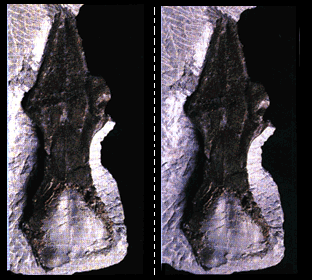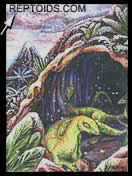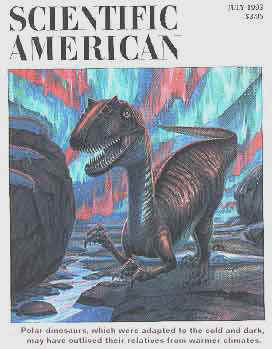|
Hundreds of millions of years ago, the Earth that the dinosaurs inhabited look quite different than it does now. In fact, the entire land mass of the Earth was drawn together by continental drift into one giant supercontinent surrounded by a single ocean called Tethys. The continent itself was called Pangaea.
At this time, Antarctica was attached to the southern boundary of Australia, forming an area that is known as polar Gondwanaland. Although polar Gondwanaland was located well within the Antarctic circle, the fossil records indicate that this area once enjoyed a climate similar to that of the state of Oregon. Paleobotanists report that Antarctica’s cool landscape was filled with beautiful conifers, ferns, evergreens and a few flowering plants which spread patches of color across the vast land. Geologists report that great mountain ranges and volcanoes pierced the horizon and rivers flowed abundantly across the terrain. What is most important to our study is that scientists have discovered that, within this enchanting and peaceful polar environment, a variety of life thrived, including dinosaurs. Additionally, along the southern cliff side of Australia, a region that was once attached to polar Gondwanaland, the remains of another Polar Dinosaur was unearthed that provided insight into the remarkable ability that certain dinosaur specied had to evolve, adapt and thrive in dark, cool environments. The dinosaurs name was LEAELLYNASAURA (Lee-Ellena-Saura):
PRE-ADAPTATION TO THE UNDERWORLD ENVIRONMENT.
Leaellynasaura was unique dinosaur in many ways. It was a large chicken sized herbivorous dinosaur with bipedal posture, long legs and well-developed digits at the end of their front limbs. The most interesting thing about this discovery was found in the fossilized skull of Leaellynasaura.
Although Polar GondwanaLand had a climate much like that of northern Oregon or Scotland, Dr. Rich knew that the seasonal extremes through which the polar Gondwanaland environment fluctuated were as unique as were the dinosaurs that inhabited this ancient region of the planet. Logic suggests that any animal species that was living in these extreme southern latitudes would either have to be: A) A migrating species that travels to northern latitudes during the four long months of Antarctic winter cold and darkness, or B) A stationary species that was physically adapted to living and thriving such bleak conditions. Dinosaurs that remained in Antarctica would have had to forge for food in freezing or sub-freezing temperatures and in the dark. How is this possible for a dinosaur? Could it be that the sheer environmental stresses of living under these polar climates encouraged dinosaurs living in this region to evolve an evermore increasingly warmer blooded physiology in order to survive? The physical adaptability and physiological survivability of some of the dinosaurs to survive in extreme low temperature environments has been estabished with the discovery of Antarctic dinsours, such as Leaellynasaura. The BIG question is: Could Antarctic dinosaurs, such as the lovely Leaellynasaura, be the perfect cadidates for adapting to the dark, cool regions of the Earth...such as caverns and caves?
GOING, GOING.....DOWN There are several reasons why it is possible that some of the polar dinosaurs may have been driven to seek the shelter of the Antarctic underworld.
|
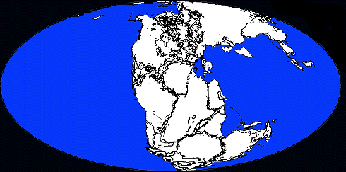 After a while, Pangaea gradually
split into two separate parts. The northern land mass (containing
the North American, Asian and European continents) gradually
fractured and spread northwards. The southernmost land mass
(containing South America, Africa, India, Antarctica and
Australia) remained fairly intact and occupied the southern
hemisphere. This southern hemispheric land mass was called
Gondwanaland.
After a while, Pangaea gradually
split into two separate parts. The northern land mass (containing
the North American, Asian and European continents) gradually
fractured and spread northwards. The southernmost land mass
(containing South America, Africa, India, Antarctica and
Australia) remained fairly intact and occupied the southern
hemisphere. This southern hemispheric land mass was called
Gondwanaland. 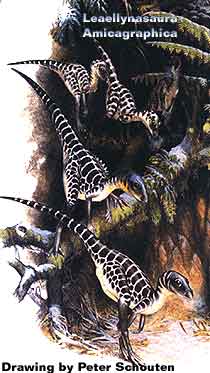 When paleontologist Tom Rich
(Museum of Victoria, Australia) discovered the fossilized
remains of the polar dinosaur Leaellynasaura in an excavated tunnel
on the southern shores of Victoria, he uncovered evidence that showed how dinosaurs were fully capable of adapting and surviving in low light and low temperature conditions.
When paleontologist Tom Rich
(Museum of Victoria, Australia) discovered the fossilized
remains of the polar dinosaur Leaellynasaura in an excavated tunnel
on the southern shores of Victoria, he uncovered evidence that showed how dinosaurs were fully capable of adapting and surviving in low light and low temperature conditions.